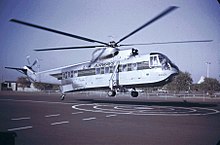Sikorsky S-61





The Sikorsky S-61L and S-61N are civil variants of the successful SH-3 Sea King helicopter. They are two of the most widely used airliner and oil rig support helicopters built.[1]
Design and development
In September 1957, Sikorsky won a US Navy development contract for an amphibious anti-submarine warfare (ASW) helicopter capable of detecting and attacking submarines.[1] The XHSS-2 Sea King prototype flew on March 11 1959. Production deliveries of the HSS-2 (later designated SH-3A) began in September 1961, with the initial production aircraft being powered by two 930kW (1250shp) General Electric T58-GE-8B turboshafts.
Sikorsky was quick to develop a commercial model of the Sea King.[1] The S-61L first flew on November 2 1961, and was 4ft 3in (1.27m) longer than the HSS-2 in order to carry a substantial payload of freight or passengers. Initial production S-61Ls were powered by two 1350shp (1005kW) GE CT58-140 turboshafts, the civil version of the T58. The S-61L features a modified landing gear without float stabilisers.
Los Angeles Airways was the first civil operator of the S-61[2] introducing them on March 1, 1962 for a purchased price of $650,000 each. [3]
On August 7 1962, the S-61N made its first flight.[1] Otherwise identical to the S-61L, this version is optimized for overwater operations, particularly oil rig support, by retaining the SH-3's floats. Both the S-61L and S-61N were subsequently updated to Mk II standard with improvements including more powerful CT58-110 engines giving better hot and high performance, vibration damping and other detail refinements.
The Payloader, a stripped down version optimised for aerial crane work, was the third civil model of the S-61.[1] The Payloader features the fixed undercarriage of the S-61L, but with an empty weight almost 2000lb (900kg) less than the standard S-61N.
A unique version is the S-61 Shortsky conversion of S-61Ls and Ns by Helipro International.[1] The fuselage is shortened by 50in (1.6m) to increase single engine performance and external payload. The Shortsky conversion first flew in February 1996.
Variants
- S-61L
- Non-amphibious civil transport version. It can seat up to 30 passengers (13 Built).
- S-61L Mk II
- Improved version of the S-61L helicopter, equipped with cargo bins.
- S-61N
- Amphibious civil transport version.
- S-61N Mk II
- Improved version of the S-61N helicopter.
- S-61 Payloader
- Stripped down machine optimised for aerial crane work; features the fixed undercarriage of the S-61L, but with an empty weight almost 900kg (2000lb) less than the standard S-61N.
- S-61 Shortsky
- Shortened conversion of the S-61L and N, designed to increase single engine performance and external payload.
Operators
- Former operators are marked by italics
 Greenland
Greenland
- CHC Helicopter
- Canadian Coast Guard
- HeliJet
- Cougar Helicopters
- VIH Helicopters
- BEA Helicopters
- Bristow Helicopters
- British Airways Helicopters
- British Caledonian Helicopters
- British International Helicopters
- Carson Helicopters
- Columbia Helicopters
- Croman Corporation
- Los Angeles Airways
- New York Airways
- San Bernardino County, California Sherriff's Department
Notable accidents

- On August 14, 1968 Los Angeles Airways Flight 417 crashed Compton, California resulting in the loss of 21 lives. The accident aircraft, N300Ydisaster[4], serial number 61031, was the prototype of the Sikorsky S-61L.[5]
- On July 16, 1983, British Airways Helicopters' commercial S-61 G-BEON crashed in the southern Celtic Sea, in the Atlantic Ocean, while en route from Penzance to St Mary's, Isles of Scilly in thick fog. Only six of the 26 on board survived. It sparked a review of helicopter safety and was the worst civilian helicopter disaster in the UK until 1986.
- On August 5, 2008, a Carson Helicopters S-61 crashed during firefighting operations in the Shasta-Trinity National Forest in northern California. Of the 13 on board, 9 are missing and presumed dead, and four persons were taken to the hospital.[6]
Specifications (S-61N Mk II)
Data from International Directiory of Civil Aircraft[1]
General characteristics
- Crew: 2 pilots
- Capacity: up to 30 passengers
Performance
See also
Related development
References
- ^ a b c d e f g Frawley, Gerard: The International Directiory of Civil Aircraft, 2003-2004, page 194. Aerospace Publications Pty Ltd, 2003. ISBN 1-875671-58-7
- ^ Sikorsky S-61N
- ^ "The Self-Supporting Helicopter" Time Magazine December 26, 1960
- ^ "FAA Registry (N300Y)". Federal Aviation Administration.
- ^ Aircraft Accident Report. Los Angeles Airways, Inc. S-61L Helicopter, N300Y, Compton, California, Adopted: August 27 1969
- ^ McKinley, Jesse (2008-08-06). "9 Feared Dead in Calif. Copter Crash". New York Times. Retrieved 2008-08-06.
